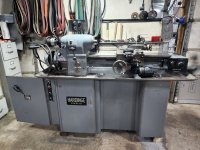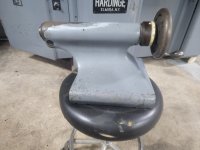marinegrunt
Plastic
- Joined
- May 21, 2022
Hi everyone. I recently purchased an HLV-H and in the process of figuring out how I want to power it. I'm completely new to Lathes, mills, etc so I apologize for my ignorance. I've been a welder for 15 years and finally got the itch to get into machining since I enjoy tinkering with metal. Anyways, I've read through many posts about converting these to vfd's or using a RPC. It seems both have their pros and cons. Many of those threads talk about 460v machines. The nameplate on mine says it's 220v and the motor label backs that up. Although, there is a 230/460 volt transformer in the electrical box. I'm not sure if that makes a difference though. I planned on just getting a 5hp RPC but thought I'd ask if anyone would recommend the VFD route since it's a 220v? It's my understanding if I go with a RPC I don't need a separate transformer since I don't need to step up the voltage to 460v.
Another thing worth mentioning is I'm not an electrician. I've wired up a couple vfd's for my 2x72" belt grinder and a round column mills but I understand it would be quite a process with the Hardinge due to multiple motors, speed control, etc. I have very basic knowledge but would definitely need guidance. That's another reason why I kind of planned on going with a RPC.
I know all of this has been talked about many times on here but I just wanted to make sure that the vfd isn't the better way to go for a 220v machine. It's not like it'll be running everyday so I'm not too concerned about power consumption. Although, I know I'd prefer the quieter operation of the vfd's.
I appreciate the help. I know I'll have plenty of other basic questions about the lathe in general and operation so you might be seeing me around quite a bit. I'm going to need some advice on getting the correct chuck for it but will worry about that after I get it up and running. There are a couple Hardinge 5" on ebay that might fit the bill. My lathe has the 5c closure with the threads.
Thanks!
Another thing worth mentioning is I'm not an electrician. I've wired up a couple vfd's for my 2x72" belt grinder and a round column mills but I understand it would be quite a process with the Hardinge due to multiple motors, speed control, etc. I have very basic knowledge but would definitely need guidance. That's another reason why I kind of planned on going with a RPC.
I know all of this has been talked about many times on here but I just wanted to make sure that the vfd isn't the better way to go for a 220v machine. It's not like it'll be running everyday so I'm not too concerned about power consumption. Although, I know I'd prefer the quieter operation of the vfd's.
I appreciate the help. I know I'll have plenty of other basic questions about the lathe in general and operation so you might be seeing me around quite a bit. I'm going to need some advice on getting the correct chuck for it but will worry about that after I get it up and running. There are a couple Hardinge 5" on ebay that might fit the bill. My lathe has the 5c closure with the threads.
Thanks!




